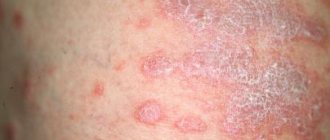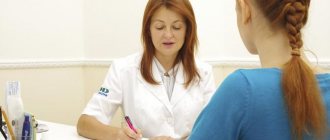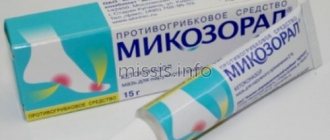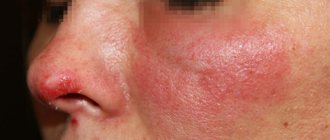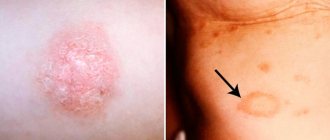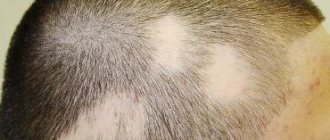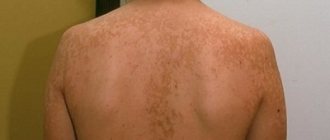The article was prepared by a specialist for informational purposes only. We urge you not to self-medicate. When the first symptoms appear, consult a doctor.
Tinea versicolor is a skin disease that most often affects people living in countries with hot and humid climates. Dermatological manifestations of the disease most often occur after a person has spent a long time in the sun. In Russia, no more than 10% of the population suffers from tinea versicolor. You can also find such names for color lichen as “pityriasis versicolor” or even “sun fungus”. However, they will indicate a single problem.
Ringworm has a wave-like course, with periods of exacerbation and calm. At risk for developing the disease are people who are prone to various dermatomycosis. Relapses of the pathology most often occur in the warm season. There are no signs of an inflammatory reaction on the skin during an exacerbation of the disease.
Tinea versicolor cannot be called a dangerous disease, since it does not pose a threat to health. Therapy is usually not complicated and highly effective. However, the presence of spots on the skin can cause a feeling of psychological discomfort associated with a defect in appearance.
Symptoms and causes
Symptoms determine the method of treatment. The way lichen versicolor looks like helps a specialist choose a method for effective treatment. With standard manifestation, rounded spots gradually increase in size and merge.
The longer treatment is delayed, the more extensive the skin lesions will be.
The appearance of lichen versicolor can be triggered by chronic infection, chronic sweating, or close contact with another sick person. The pathology is contagious and is transmitted through direct contact with the area. Characterized by:
- lack of inflammation;
- peeling of the skin;
- the presence of pink, brown, brown spots;
- localization on the neck, back, abdomen.
It can occur with or without itching. It occurs more often in patients living in hot, humid climates. The appearance could be triggered by a sudden change in weather conditions, a trip to the sea, insufficient hygiene, clothing made of synthetic fabrics, diabetes mellitus, obesity or prolonged depression.
Causes of infection
The causative agent of the disease is a yeast-like fungus, known in 3 forms: round Pityrosporum orbiculare, oval Pityrosporum ovale and mycelial Malassezia furfur, which can take different shapes.
It lives on human skin constantly, but is activated only under the influence of certain factors:
- violation of hygiene rules;
- for diabetes mellitus;
- profuse sweating - both during heat and during certain diseases, tuberculosis, for example;
- in case of disturbances in the functioning of the endocrine system and some diseases of the gastrointestinal tract, the opportunity for the fungus to “prove itself” appears due to changes in the acidity of the skin;
- immunodeficiency - both due to illness or general weakening, and as a result of taking certain medications: cytostatics, glucocorticoid hormones.
Until recently, it was believed that it was very difficult to catch pityriasis versicolor from a sick person, however, recent research in this area refutes the early conclusions of scientists. Nowadays, dermatologists are inclined to believe that pityriasis versicolor can appear not only after personal contact with an infected person, but also when sharing household items (bed linen, towels, washcloths, clothes).
Thus, it is quite possible to pick up a fungus even in the fitting room of a clothing store. The first symptoms of pityriasis versicolor appear within a period of several weeks to several months. The duration of the incubation period depends on the state of human health and the presence of provoking factors, which we already wrote about just above.
Treatment methods
Alarming symptoms in the form of redness, burning, the appearance of pustules and the formation of spots signal the development of multi-colored lichen. At the initial stages, patients are often treated with folk remedies, but this leads to a worsening of the situation. They go to the doctor at the next stage of development.
Purulent processes are the result of the penetration of a secondary infection through the skin.
Pityriasis versicolor is treated with tablets, ointments, and creams. The main thing is to achieve intensive exfoliation of the epidermis. The skin is cleansed of fungi and affected tissues. The deeper the treatment penetrates, the faster the effect will be noticeable. For infectious diseases, a wide range of medications are used.
Methods can include either a single component or a set of measures. More often, treatment with tablets is accompanied by the use of ointments and dietary supplements. Your doctor may prescribe compresses to relieve itching.
Medications
Treatment options are often systemic in nature. Antifungal drugs, sprays, creams with intense effects help treat the disease and relieve unpleasant symptoms. The method is selected regardless of whether the lichen is on the back, face or neck. In the fight against the disease, imidazoles, triazoles, and allylamines are used.
| Effective ointments, gels | ||
| Name | Peculiarities | Price |
| Travogen | Antimicrobial, antifungal drug. Apply once a day to the affected area. | From 480 rub. |
| Lamisil | Destroys pathogen cells. Apply once a day to cleansed skin for a month. | From 520 rub. |
| Exoderil | Apply once a day for four weeks. Destroys fungi and bacteria, stops the development of the pathogen. | From 440 rub. |
| Antifungal drugs | ||
| Orungal | Stops the proliferation of fungi, take one tablet a day for a week. highly effective drug. | From 2,000 rub. |
| Nizoral | Suppresses the development of pathogenic microflora. Relieves symptoms in a short time. | From 350 rub. |
| Fluconazole | A highly effective antifungal agent. The dosage regimen is prescribed individually. | From 30 rub. |
| Products for treating affected areas | ||
| Kanesten | A drug with a wide spectrum of action. Spray onto the affected area twice a day for three weeks. | From 1,600 rub. |
| Thermikon | A spray that has an antibacterial and antifungal effect. Apply twice during the day. The course lasts up to seven days. | From 350 rub. |
| Fungoterbin | Destroys bacteria, fungi, stops the development of pathogenic microflora. Within seven days it completely eliminates symptomatic manifestations. | From 300 rub. |
Your doctor may recommend salicylic acid. The solution is prepared in individual proportions. Wipe the affected areas to prevent fungal growth and infection. It is acceptable to prescribe Betadine, Vocadine and Iodopirone.
Other means
Lichen versicolor can be cured at home only with medication. But traditional medicine will help minimize unpleasant symptoms and prevent the recurrence of the disease. Use:
- infusion of pine needles;
- infusion of blackberry and calendula leaves;
- peppermint decoction;
- homemade St. John's wort ointment;
- boiled buckwheat compress.
If the pills do not help, the doctor may prescribe complex therapy. In conditions of extensive lesions, medications, physiotherapy, and the use of drugs to exfoliate the stratum corneum are used. Multicomponent treatment may include:
- Ultrasound therapy
. Reduces the frequency of exacerbations, stops the development of pathogenic bacteria. Strengthens the effect of medications. - Laser therapy
. Activates natural skin regeneration, normalizes local immunity. Can be used contact or remotely. - Ultraviolet medium wave therapy
. Increases the effectiveness of natural defense mechanisms and has a beneficial effect on the skin.
A complex effect on the lesions and the internal pathogen will allow you to quickly reduce the frequency of symptoms, relieve itching and irritation. The spots of pityriasis versicolor gradually fade and disappear from the skin. After competent therapy, there are no scars, scars or other visible marks on the skin.
Mycozoral against lichen
Ketonazole in the drug actively fights against fungi, bacteria and microbes. Effective treatment is possible even when the skin is damaged by staphylococci, streptococci, dermatophytes or yeast fungi. Positive dynamics are visible on the second day of treatment.
When used correctly, it prevents the reappearance of pityriasis versicolor.
The drug has a number of serious side effects and contraindications. A medical specialist will recommend strictly adhering to the dosage. Use the ointment for no longer than seven days, apply a thin layer once a day. Children and pregnant women are prohibited from using the ointment. Does not affect the blood when applied topically.
For children, tablets are prescribed. The dosage is calculated based on the child's weight. It is acceptable to use a soap solution or shampoo for prevention. A cumulative effect is possible, so the doctor prescribes an individual dosage for any form of medication.
Fluorocort as a method of treatment
A highly effective drug with a wide spectrum of action. A viscous ointment without an intense odor prevents the further spread of the disease. On the second day, lichen becomes non-contagious and is not transmitted by contact. Advantages of the drug:
- reduces the intensity of symptoms;
- reduces foci of exudative processes;
- reduces the migration of phagocytes;
- improves skin regeneration.
The use of ointment is prohibited if you are individually intolerant to the components. Prohibited for skin tuberculosis, trophic ulcers, acne. Do not apply to open wounds or severe bleeding scratches. In such cases, another remedy is selected.
Fluorocor is actively used in the initial stage of lichen, then the frequency of use decreases. Substances accumulate and affect the pathogen. The lesions are destroyed and the symptoms are relieved. Gradually, the spots turn pale and disappear from the skin without a trace.
Diagnostics
For an experienced dermatologist, an external examination of the patient is enough to suspect he has lichen colorus.
However, to clarify the diagnosis, a number of tests will be required, including:
- Microscopic examination of skin scrapings from spots. Under a microscope, the doctor examines the dermal scales, which are pre-treated with a 20% KOH solution. The fungi that cause tinea versicolor will be represented by long filaments with rounded growths located on them.
- Test using iodine. During the study, the skin is treated with a 5% iodine solution. After a few minutes, the tinea versicolor spots turn dark brown.
- Using a Wood's lamp for diagnostics. In the light of its rays, the spots acquire a reddish-yellow tint or a greenish-golden color.
- Check for Beignet's sign , in which skin particles flake off easily, even with minor scraping.
This is a complete list of diagnostic methods that allow you to identify tinea versicolor. In practice, doctors most often use only the iodine test and Wood's Lama.
Clotrimazole for the treatment of lichen
A popular ointment for the treatment of versicolor. Clotrimazole is used up to three times a day. The doctor can increase the course, extend it from two weeks to four. The dosage often remains standard and is not selected individually. The skin is thoroughly washed with baby soap, dried and the drug is rubbed in with massage movements.
Destroys pathogens and prevents the migration of pathogenic bacteria. Reduces the intensity of symptoms. A topical antifungal agent is equally effective on both the skin and mucous membranes.
Not prescribed for children under twelve years of age.
The drug activates local immunity and activates defense mechanisms. Forms chemical compounds that negatively affect the development of infected cells.
On the first day, it disinfects the affected area. Undesirable reactions include pain, breathing problems, discomfort and redness of the mucous membranes, and irritation around the application site.
Mycoseptin as a universal remedy
Combination type drug. In the first day, it minimizes the infectivity of the affected area. Has a detrimental effect on fungi, bacteria and pathogenic microflora. Destroys active damaging bacteria. Significantly accelerates tissue regeneration and activates local immunity.
It is permissible not just to lubricate the area, but to apply a bandage.
Symptoms will disappear in the first few days. But the doctor will recommend continuing treatment and using the ointment according to a certain regimen. More often once a day for seven days, then up to five weeks applied once every two days. Used to treat candidiasis, dermatomycosis, mycosis. It is prohibited to use when:
- high sensitivity to the components of the drug;
- the presence of ulcers and open skin lesions;
- the presence of weeping wounds;
- blisters.
Unlike analogues, it is allowed during pregnancy and breastfeeding. This is due to the fact that the ointment is not absorbed into the blood and does not have any effect on the development of the fetus or the composition of breast milk. Equally effective both in the initial stage and in advanced cases.
Coeval with Hippocrates
The name “lichen” (Lichen) has been known since the time of Hippocrates; it includes many skin diseases, which are characterized by the formation of colored spots and peeling. The name “lichen” itself is very arbitrary, since, for example, herpes is popularly called herpes zoster, psoriasis - scaly, etc., but these skin diseases can only be classified as lichen. Different types of lichen are caused by a wide variety of reasons - fungus, virus, but in many cases, reduced immunity is one of the main provoking factors. In this article we will talk about multicolored or, as it is also called, pityriasis versicolor. The causative agent of pityriasis versicolor was described by G. Robin in 1853, and in 1951 M. Gordon identified round and oval forms of the pathogen both in places of pityriasis versicolor rashes and within healthy skin, classifying it as a yeast-like fungus, and proposed its rounded version call Pityrosporum orbiculare.
Preventive measures
Tinea versicolor is contagious, but you can become infected not only through direct contact. To avoid unpleasant symptoms, doctors give the following recommendations:
- You should not be on wild, unkempt beaches;
- when visiting public baths, wash your skin thoroughly with a sponge or washcloth;
- use sunscreen from pharmacies;
- use only a personal towel;
- take a shower after vigorous physical activity.
In addition to taking medications, immunity plays an important role. Hardening the body and taking immunomodulators will eliminate the appearance of pityriasis rosea and other fungal skin lesions. For patients with the chronic form, regular bathing with sea salt and compresses with vinegar or salicylic alcohol are acceptable.
Skin pathology can be avoided if changes in the epidermis are noticed in a timely manner. Redness, causeless itching, and the appearance of tiny blisters signal a pathological process. The sooner the patient sees a doctor, the more effective and faster the treatment will be.
How to prevent the disease?
In order to prevent relapses, local treatment is carried out during the warmest periods of the year. The scalp is treated with ketoconazole shampoo. This shampoo can also be used as a shower gel, rubbing the body with it every month for 3 days in a row for up to 5 minutes. The rest of the time, the skin is lubricated with 1% salicylic alcohol once a week.
Despite the fact that pityriasis versicolor is not considered a contagious disease, it is recommended to carefully monitor the contact of family members of the patient with his clothing, personal hygiene, or bedding. All those suffering from this disease must have their own set of bed linen, towels and clothing. During treatment, disinfection of the patient's linen and clothing is carried out by boiling in a 2% soap-soda solution, followed by ironing five times with steam. Synthetic materials should also be avoided. Preference should be given to cotton fabrics.
People suffering from pityriasis versicolor are advised to avoid stressful situations, increased physical activity, excessive sweating, and high temperatures. We should also not forget about strict adherence to the rules of personal hygiene.
Additional Information
Multi-colored pityriasis versicolor affects the epidermis and grows. The disease is contagious and can be transmitted through direct contact with a person or a hygiene item. There are three forms of the disease:
- Inverted
. Rashes form in folds, in areas of increased sweating. There is no pain or inflammation. - Follicular
. Complex form of lichen. Large spots form and itching begins. Ulcers form on the affected surface. - Erythematous-squamous
. It occurs without inflammatory processes. Spots of different sizes appear, often without itching or burning.
A properly selected remedy will reduce the intensity of symptoms in the first day. Even after the spots disappear, treatment continues according to the scheme. If you stop taking medications ahead of schedule, the fungus will become active after a short period of time.
Therapeutic treatment is aimed at getting rid of discomfort, stopping fungi and bacteria, and destroying the outbreak. The skin is intensively exfoliated to get rid of deep lesions. The specialist often prescribes a complex intake of medications, ointments, and recommends combining them with physiotherapy.


